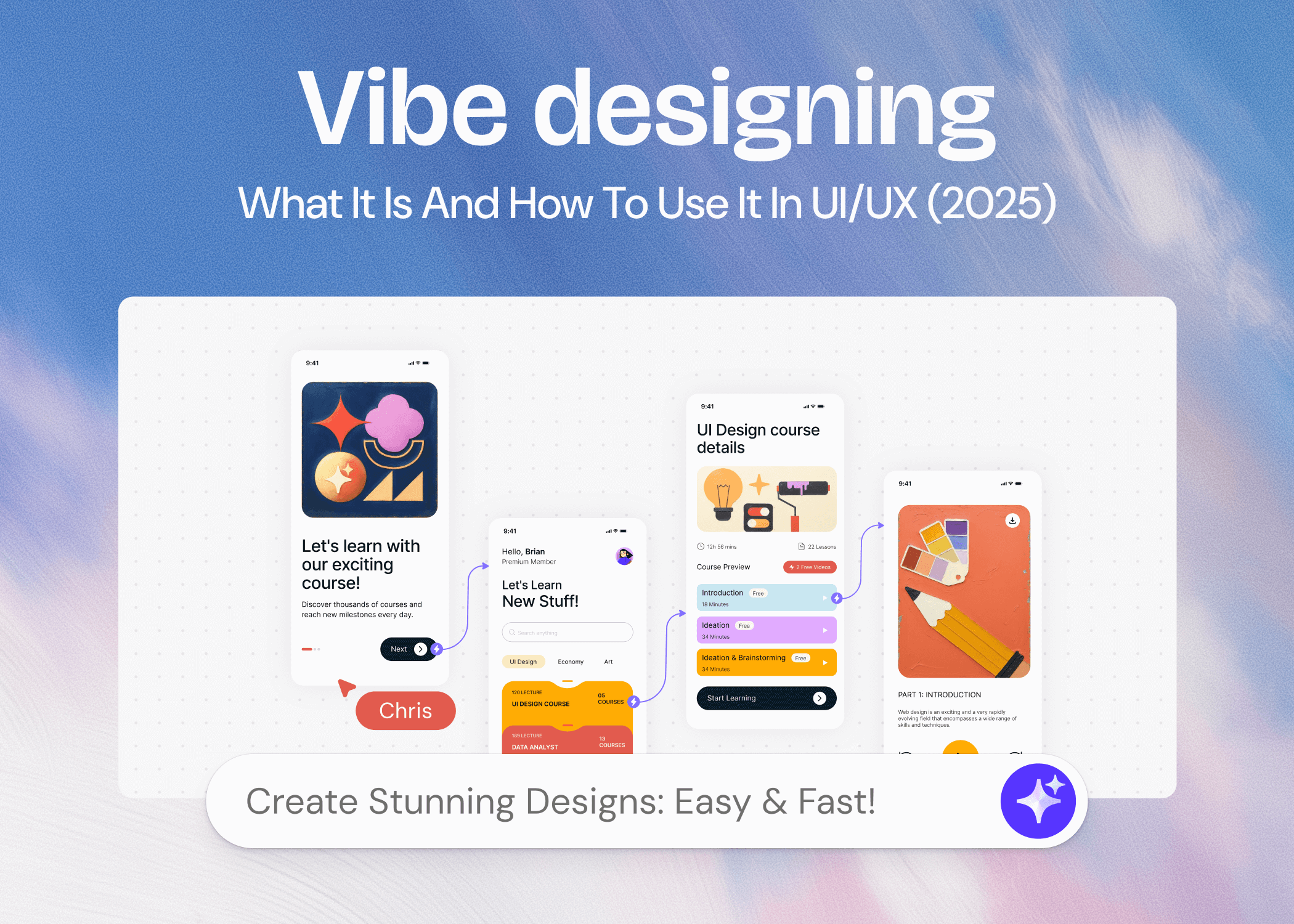Vibe designing is a fast, flexible approach to product design and ideation. It allows teams to generate and modify UI wireframes or prototypes using multiple inputs—such as images, text prompts, URLs, or diagrams. This process is powered by multimodal AI and complemented by intuitive canvas-based editing.
A defining principle of vibe designing is what we call Action-Modality Match: letting users choose the most natural way to complete an action. For example, AI can handle creative leaps like turning a screenshot into a prototype, while simple edits—moving a button, changing a color, or replacing a shape—are faster and more natural with drag-and-drop tools. This balance makes vibe designing accessible to both non-designers and experienced designers alike.
What is vibe designing?
Vibe designing is the practice of using multi-modal AI design tools to generate and edit UI designs through text, images, URLs, or even diagrams. In vibe design tools, these AI features complement drag-and-drop interfaces, design pre-sets, and customizable elements to allow non-designers and designers alike to control the look and feel of UI wireframes and prototypes. The combination of AI and simple design tools create a balance between speed and flexibility, which is at the core of the vibe designing experience.
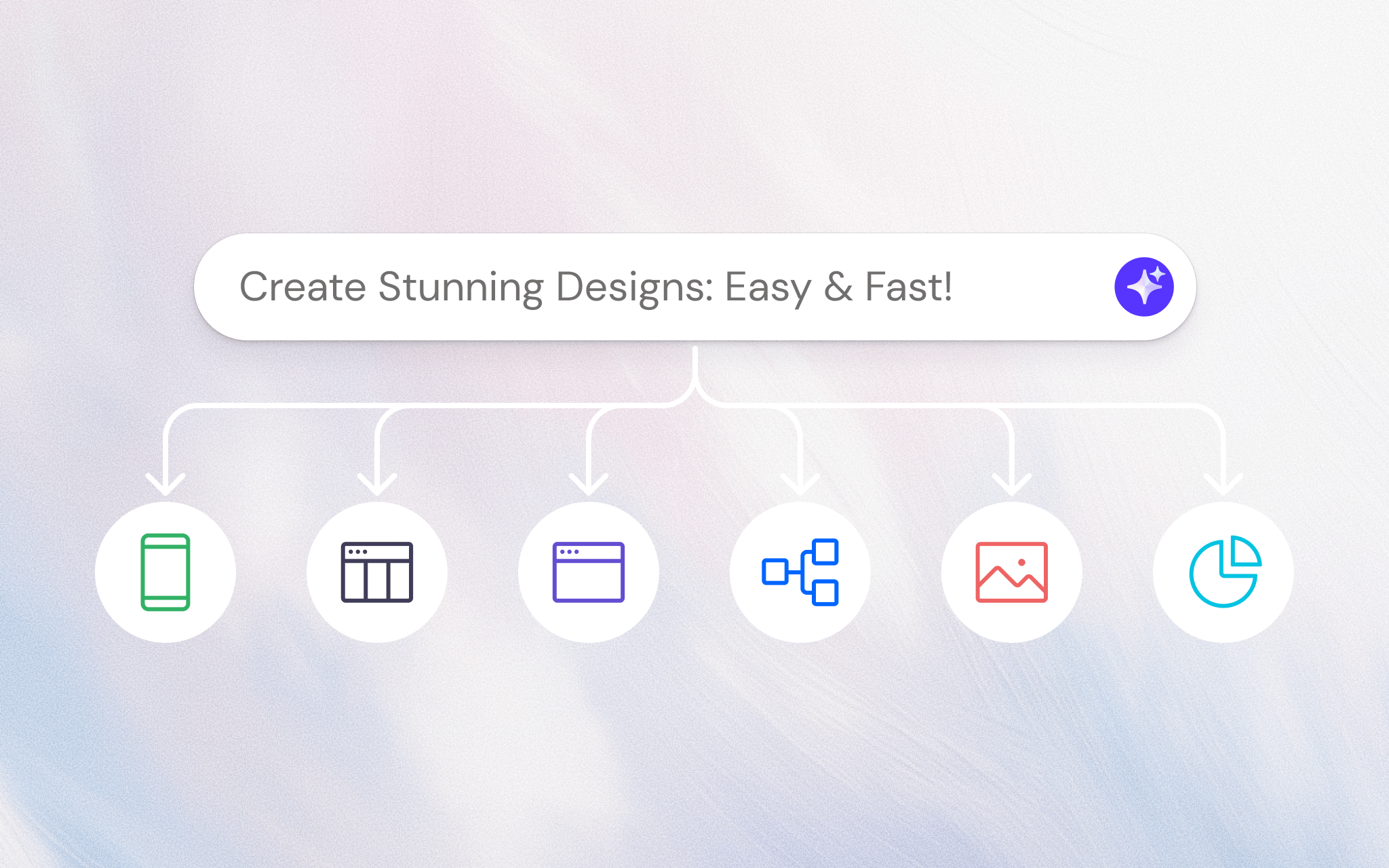
The emergence of vibe designing has been fueled, at least in part, by the frustration of non-designers unable to convey their product ideas adequately due to the complexity of modern design tools. By using AI to fill the knowledge and skill gaps of non-designers, vibe design tools have become deeply integrated to the modern product design and development process, especially among software product managers, business analysts, designers, and engineers.
When should you vibe design?
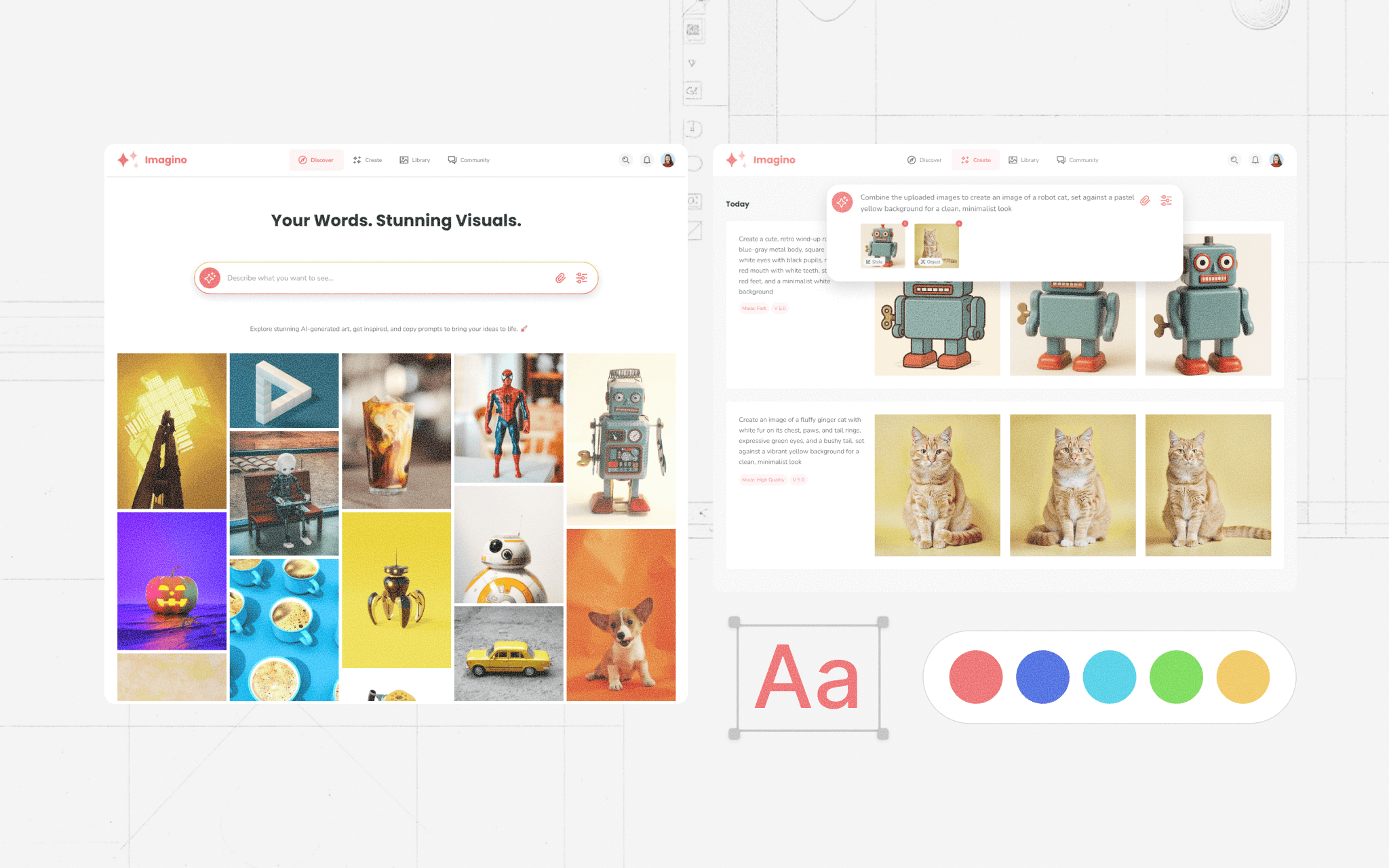
For designers, vibe designing is often a quick way to prototype ideas, explore different layouts & aesthetics, or get feedback. The key word here is “quick”: designers are typically capable of producing the types of assets a vibe designer assists them in creating, but vibe designing saves time and effort—particularly on exploratory work.
The flip-side is that some designers simply prefer to wait to showcase ideas until they’ve applied more polish to them, in which cases, they may choose to follow a more traditional design process. Below is a quick comparison of the primary differences between vibe designing and a more traditional design process (i.e. one that does not leverage AI for design assistance):
| Vibe designing | Traditional design process | |
|---|---|---|
| Input methods | Images, text prompts, URLs, diagrams | Manual element creation, component libraries |
| Polish | High-fidelity, potentially dev-ready | Pixel-perfect, dev-ready |
| Accessibility | Anyone (Product Managers, Designers, Developers, Business Analysts, etc.) | Designer-centric |
| Speed | Minutes to hours | Hours to days |
In contrast to designers, non-designers gain an entire new skill through the use of vibe design tools, making them not so much a “nice-to-have” as a necessity when seeking buy-in or understanding of their ideas.
Ultimately, the decision of whether to vibe design or stick to traditional wireframing or prototyping methods depends on your goals, skills, and preferences, but there are some situations that clearly favor one or the other:
| Role | Goal | Vibe design | Traditional design process |
|---|---|---|---|
| Designer (production mode) | create pixel-perfect designs for development, using existing design system and libraries. | ❌ | ✅ |
| Designer (exploration mode) | create quick mockups or prototypes for client, team, or executive feedback or buy-in. | ✅ | ❌ |
| Non-designer | convey polished-looking UI ideas with clients, team, or executive | ✅ | ❌ |
How is “vibe designing” different from “vibe coding”?
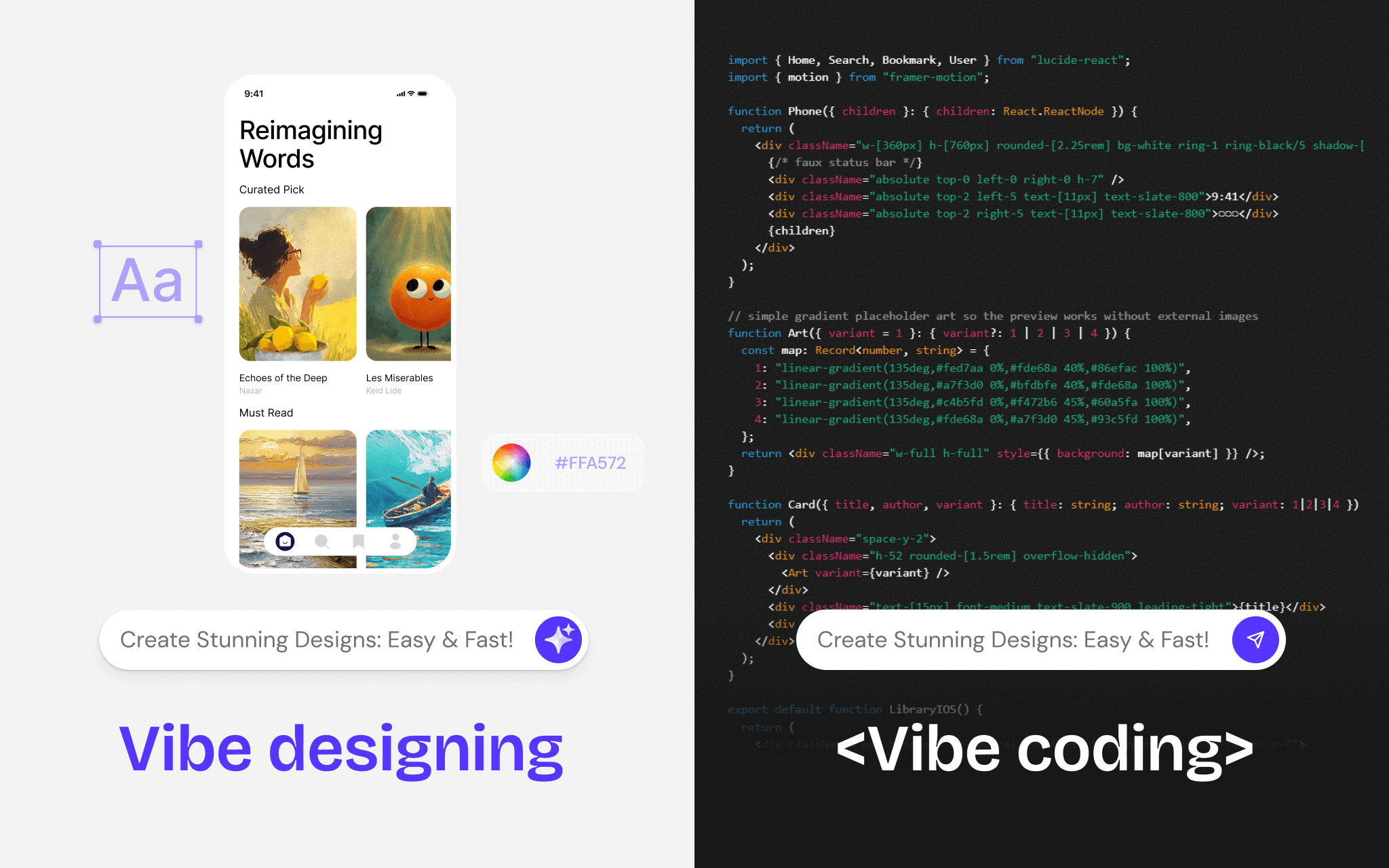
Vibe designing combines multi-modal AI inputs (text, image, etc.) and easy editing tools anyone can use, such as drag-and-drop canvas elements. The goal of vibe designing is to create UI wireframes and prototypes that can be easily customized.
Vibe coding also leverages multi-modal AI but has a distinct focus on natural-language text inputs to generate actual applications. Because of the constraints presented by code, modifications are more difficult while vibe coding: users must typically make edits with text prompts or through code edits.
In the end, the differences between the two approaches are somewhat by design: while vibe coding focuses on textual instruction and logic, vibe designing blends intent and visualization. Most design work is through “feel” — shapes, colors, and flow — rather than syntax.
👉 To explore this distinction in depth, read Vibe Designing vs. Vibe Coding for examples of how each method fits different stages of product creation.
So, which type of tool should you select for your project? That completely depends on your goal, but here’s a table to help you decide what your project merits:
| Goal | Vibe designer | Vibe coder |
|---|---|---|
| Create easy-to-edit prototype of UI or wireframe screens | ✅ | ❌ |
| Create usable app for daily work | ❌ | ✅ |
| Generate multiple UI flows for comparison | ✅ | ❌ |
| Create quick prototype with no need to edit specifics | ✅ | ✅ |
The vibe designing workflow
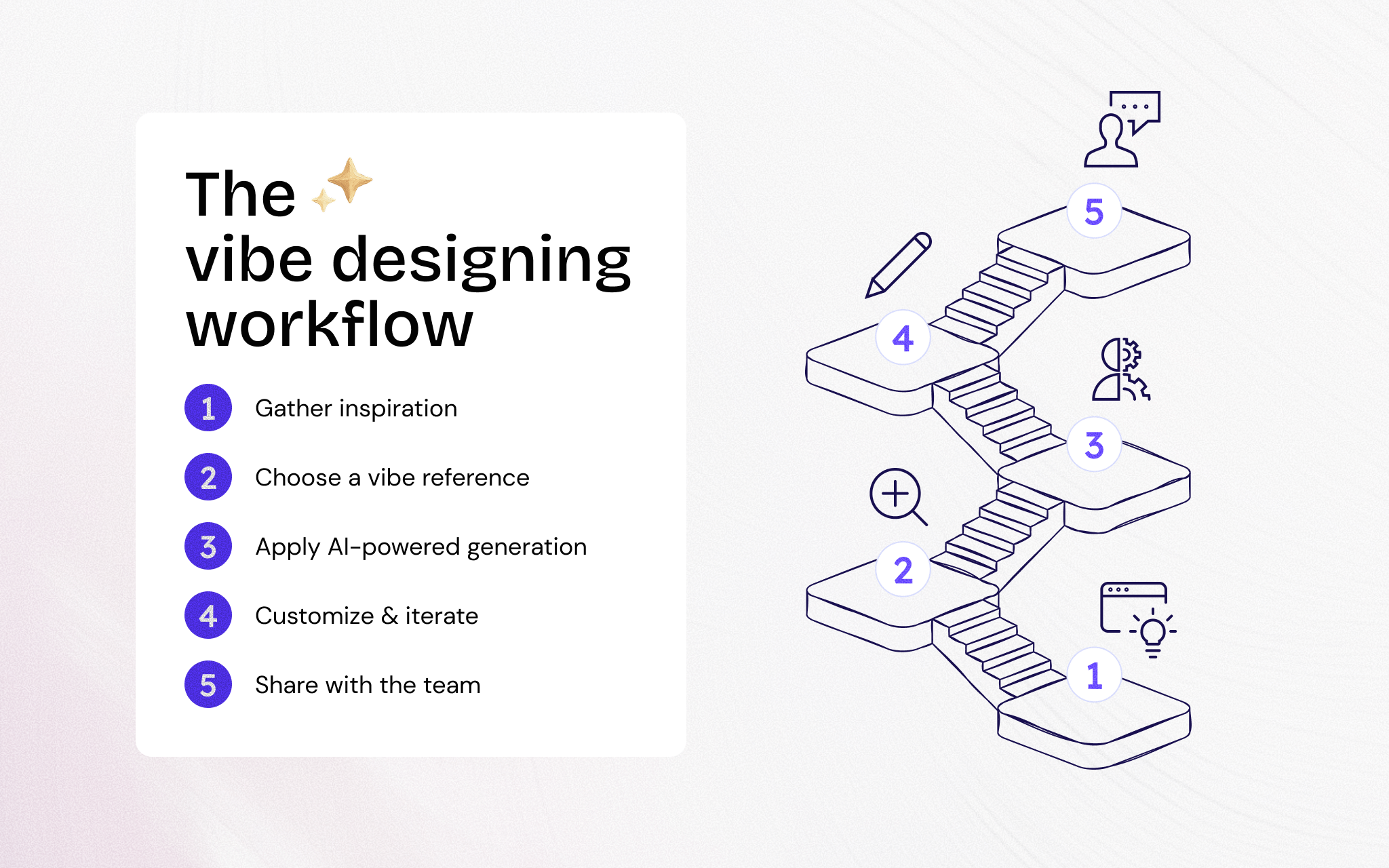
Vibe designing is as much about workflow as it about a single step in the product development process. This is because, fundamentally, it’s made to be iterative: the efficiencies of AI-assisted prototyping, coupled with the fact that anyone on the team can easily update, re-run, or modify anything in the design, means vibe designing allows for better collaboration and exploration. At its best, vibe designing is a lightweight, iterative process rather than a rigid method. Here’s how a typical workflow unfolds:
- Gather inspiration — Start with screenshots, competitor URLs, or quick sketches that capture the product’s intended feel. In tools like Visily or Miro, these can be saved on the same board where your AI-generated designs will live.
- Choose a vibe reference — Select the image, template, or diagram that best communicates your idea.
- Apply AI-powered generation — Use a tool like Visily to instantly transform that input into a wireframe or prototype.
- Customize & iterate — Make big changes with AI when needed, but refine details directly on the canvas using drag-and-drop.
- Share with the team — Invite stakeholders to comment or edit, ensuring everyone contributes to shaping the product vision.
This workflow emphasizes flexibility: AI accelerates the heavy lifting, while manual tools keep refinement fast and intuitive. Together, they create a process that is both efficient and collaborative—well-suited for product managers who need to move from idea to prototype with minimal friction.
Vibe designing best practices
Even in this nascent stage of vibe designing, a few core best practices have already emerged. As practitioners wade deeper into the vibe design waters, they’ve found several useful tips for those getting started:
- Do it early (and often) in the product development process: The beauty of vibe designing is that it can easily be picked up and put down at various points in the product development process. At each critical juncture when the team is developing solutions or new ideas, iterations can be created in mere minutes. As such, while it’s good to incorporate a concrete step for vibe designing (typically early, during the ideation phase), don’t reserve it for only that stage in the process. It’s a great way to get “un-stuck”.
- Choose the right modalities: The explosion of AI chat tools has led many to believe that everything can (and should) be done with text prompts; however, for many actions, it’s both less efficient and less intuitive to use text prompts. For actions like changing text on a single element, moving an element from one container to another, or other one-off actions, using easy canvas tools is often faster and allows you more precision than trying to describe the exact change you want. Similarly, developing a sense for which input types in a multimodal AI tool get you the desired output will save you time and frustration in the long run.
- Organize your inspiration: vibe designing is infinitely easier if you have a well-organized repository of ideas, images, and general inspiration you like. Knowing what you hope to achieve is one of the best ways to refine your vibe designing abilities and achieve the best quality output.
How Visily enables vibe designing
Visily is a vibe design tool that helps both designers and non-designers convey their UI ideas with speed and precision. Visily was built around the core principles of vibe designing—speed, flexibility, and accessibility. Its multimodal AI lets users generate prototypes from text prompts, screenshots, templates, or even URLs, instantly turning raw inspiration into editable designs.
But unlike rigid AI-only tools, Visily emphasizes Action-Modality Match: AI is used for the creative leaps, while an intuitive drag-and-drop canvas makes everyday edits effortless.
- Need to move a button, change a color, or swap a component? Just click and adjust.
- Want to transform a screenshot into a working wireframe? Let the AI handle it in seconds.
This balance of automation and manual control allows both product managers and designers to contribute fluidly, speeding up ideation and making collaboration feel natural rather than forced.

FAQs
Vibe designing is a flexible approach to creating UI prototypes that combines multimodal AI and easy-to-use canvas design tools. It allows teams to generate and modify UI wireframes or prototypes using multiple inputs—such as images, text prompts, URLs, or diagrams.
Vibe designing combines multi-modal AI with easy-to-use canvas design tools to allow anyone to create UI prototypes; vibe coding primarily leverage natural-language text prompts to develop app.
You can learn more here.
There’s a growing number of vibe design tools in 2025. Among the most popular are:
- Visily
- Miro AI
- Figma Make
Action-Modality Match is the practice of encouraging users to perform actions in the most natural, intuitive ways. Common examples of this are allowing users to drag a button across a screen (instead of requiring a text prompt to perform the action) or suggesting AI assistance to help a user generate screens for multiple possible user flows. Action-Modality Mismatch is the practice of constraining users to perform actions in unnatural or inconvenient ways, such as requiring a text prompt to move a button—a slower, more laborious alternative to allowing them to manually move it.


